Exploring the Value of Megalodon Teeth
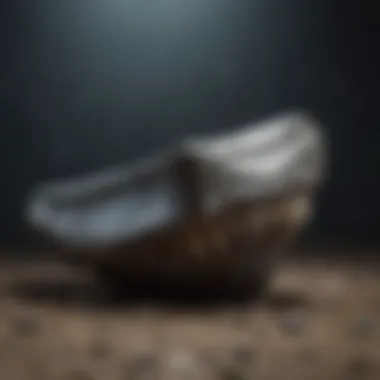
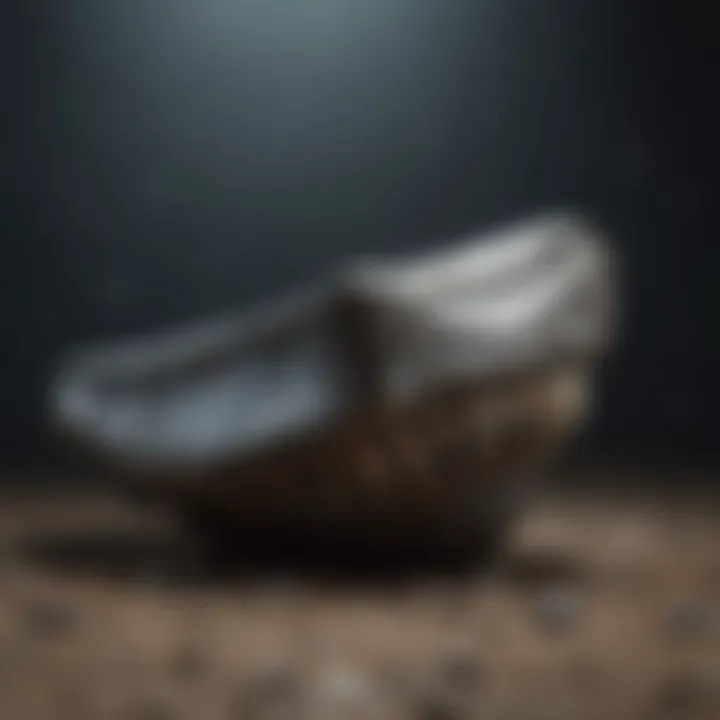
Intro
The fascination surrounding megalodon teeth is as deep and intricate as the ocean depths where these ancient giants once roamed. With their massive size and distinctive serrated edges, megalodon teeth hold great value for collectors, historians, and paleontology enthusiasts alike. Not just mere fossils, these remnants from a bygone era symbolize a connection to the earth's history, drawing attention for their aesthetic and scientific significance.
Featured Collectible of the Month
Overview
Megalodon teeth often find themselves at the top of many collectors' wish lists. Their striking appearance is not simply a product of their colossal size, which can exceed seven inches; it's also about the allure of owning a piece of history. These fossils tell the tale of a predator that dominated marine ecosystems millions of years ago. Collectors appreciate them not only for their rarity but also for their storytelling potential, linking us to a distant past filled with life and mystery.
Historical Significance
The megalodon, scientifically known as Carcharocles megalodon, lived approximately 23 to 3.6 million years ago during the Cenozoic Era. Often depicted as the ocean's apex predator, this colossal shark had a reputation that still ignites the imagination today. The teeth—many of which have been discovered in sedimentary deposits—act as key pieces of evidence for understanding ancient marine life and environmental conditions. They provide insight into the evolutionary history of sharks and their ancestors.
Furthermore, megalodon teeth have been pivotal in shaping both popular culture and scientific discourse. Their frequent appearances in media and literature have elevated their status to not just scientific curiosities but also cultural symbols that resonate deeply with the public.
"A single tooth can bridge millions of years, bringing stories from the depths of history right into our hands."
This intersection of history and science offers a rich narrative that makes megalodon teeth desirable not just for their physical attributes but for the awe they inspire.
Identification Techniques
Visual Characteristics
One may wonder—how does one differentiate a genuine megalodon tooth from replicas or other fossilized teeth? The key lies in a few distinct visual characteristics:
- Size and Shape: Megalodon teeth are significantly larger than those of modern sharks, with a broad, triangular shape and long serrations along the edges.
- Coloration: The color can range from black to brown, and sometimes even shades of gray or green, influenced by their sedimentary deposits.
- Texture: The enamel is usually glossy; an important sign of authenticity is the distinctive pattern of the serrations.
Identifying these features helps collectors assess authenticity and ensure that their prized possessions are genuine.
Resources for Identification
For those who want to delve further into the identification process, several resources can aid in distinguishing megalodon teeth:
- Wikipedia: Megalodon
- Britannica: Megalodon Teeth
- Groups on platforms like Reddit offer community support for identifying fossils and sharing knowledge.
Arming oneself with this knowledge not only enriches the collecting experience but also cultivates a deeper appreciation for these magnificent relics from the natural world.
Preface to Megalodon Teeth
Megalodon teeth pique the curiosity of many, acting as tangible links to a bygone era. Not only do they represent remnants of the formidable Megalodon shark, one of the largest predators to have ever roamed our oceans, but they also capture the imagination of collectors and enthusiasts alike. Understanding the value of these teeth involves diving into the characteristics that make them unique, their historical context, and the various factors influencing their worth in today’s market.
Overview of Megalodon
Megalodon, scientifically known as Otodus megalodon, lived approximately 23 to 3.6 million years ago during the Cenozoic Era. This ancient shark is a significant part of our planet's paleontological history. They were not just any ordinary creature; they reached lengths up to 60 feet or more, with some estimates suggesting they could have been even larger. Their massive jaws could exert an estimated force exceeding 18 tons, making them apex predators of their time. What we know about Megalodon mainly comes from their teeth, as they are among the few remains that persist through time. Fossils largely tell the tales of prehistoric life, and in this case, megalodon remains a daunting symbol of strength and dominance in marine environments.
Fascination with Fossils
The allure of fossils, particularly megalodon teeth, is undeniable. Fossils serve as whispers from the past, bridging the gap between history and present. Teeth, in particular, are revered not only for their size but also for their intricate design—each specimen tells its own story of ancient oceanic life and the environment in which it thrived. Collectors often regard them as both scientific treasures and symbols of power.
Factors contributing to this fascination include:
- Historical Significance: They tell of a time when colossal sharks ruled the seas, providing insight into prehistoric ecosystems.
- Aesthetic Appeal: The natural beauty and unique characteristics of each tooth make them desirable artifacts.
- Educational Value: They serve as teaching tools about evolution and extinction, highlighting the dynamic nature of life on Earth.
- Cultural Impact: The robust image of the Megalodon often appears in pop culture, perpetuating a sense of wonder and curiosity about these giant creatures.
Understanding megalodon teeth not only involves appreciating their physical attributes but also recognizing their place in history and culture. This section lays the groundwork for deeper exploration into their characteristics, market value, and educational role, all of which enrich our understanding of these intriguing relics.
Megalodon Teeth: Characteristics and Formation
Megalodon teeth serve as a fascinating entry point into the shark’s world and the prehistoric seas they dominated. Understanding the characteristics and formation processes of these teeth not only enriches the narrative surrounding megalodon but also enhances the appreciation for their value. Analyzing their physical attributes and formation sheds light on what makes these teeth unique, giving collectors and enthusiasts a clearer gauge for quality—both in intrinsic and financial terms. It is crucial to dive into certain aspects such as size, color, and the very process that saw these teeth become fossils. These elements culminate in a comprehensive understanding that ultimately influences their market value.
Physical Attributes
Size and Dimensions
The size of megalodon teeth is arguably one of their most striking characteristics. These teeth can reach impressive lengths—from small samples of a couple of inches to colossal finds over seven inches. This dominating size reflects the sheer power and predatory nature of the megalodon itself. Such dimensions add to the allure for collectors; larger teeth are often considered more desirable, simply because they evoke a sense of awe and respect for ancient life.
It's interesting to note that the dimensions also influence the pricing structure in the market. A big, intact tooth tends to fetch a higher price tag than smaller or damaged pieces. Thus, size becomes more than spectacle—it connects directly to monetary value.
Color Variations
When it comes to color, megalodon teeth present an array of hues, ranging from deep blacks to muted browns and even vibrant amber tinges. Each color carries its own charm and histories. The shades often derived from the geological environment during fossilization add character and narrative.
Some collectors may gravitate towards specific colors based on aesthetic preferences. For instance, a glossy black tooth shines enticingly under light, drawing the eye and adding an elegant touch to a display. Certain colors are rarer than others, making them more valuable. Therefore, this diversity in color variations not only speaks to individual tastes but also influences the collectibility and worth of the teeth.
Unique Features
Megalodon teeth possess idiosyncratic characteristics that enhance their appeal. For instance, the serrations along the edges serve both a functional and aesthetic purpose. These distinctive features provide an insight into the feeding habits of the megalodon. Collectors often look for unique features—like unusual wear or shapes—that can tell a story about the tooth’s past life.
Such qualities also create the basis for cost differentiation. Unique specimens with out-of-the-ordinary wear patterns might be valued differently than typical pieces. Nonetheless, it's important to have a discerning eye when evaluating these unique features. While they can increase the tooth's appeal, they can also complicate the authenticity assessment.
Formation and Preservation
Fossilization Process
Fossilization is a remarkable process, crucial for preserving megalodon teeth. The basic premise involves the replacement of organic material by minerals—essentially turning a tooth into stone over millions of years. Understanding this process marks the important transition from a living creature to a fossil that can be admired or collected.
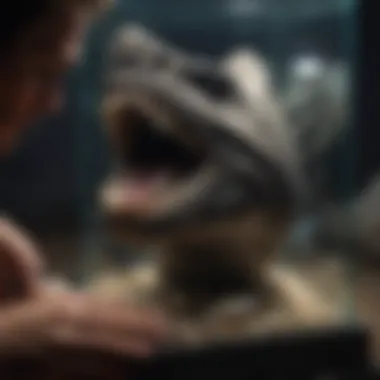
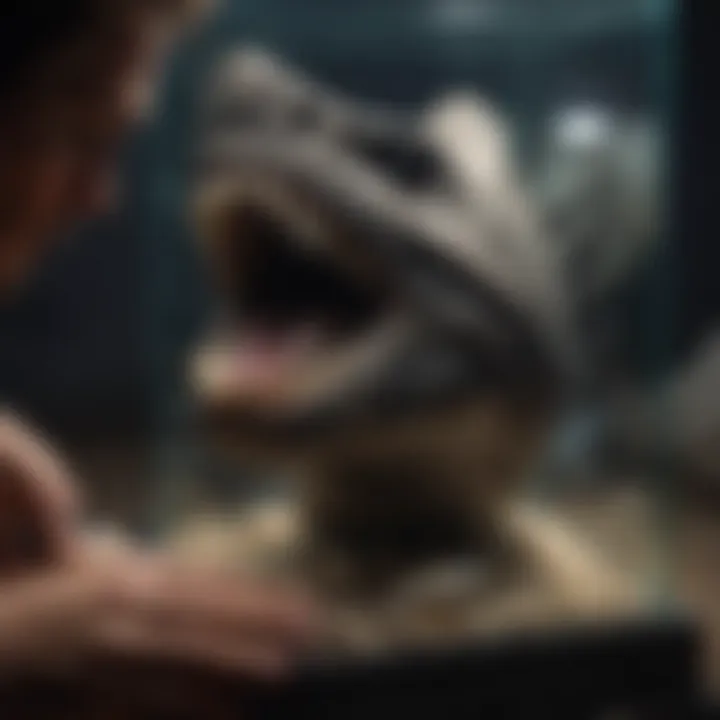
The details here are significant; some teeth fossilize more effectively than others, and this variability plays a role in their ultimate value. Factors such as existing environmental conditions, sediment types, and the age of the tooth can all affect how well it survives through the ages.
Geological Context
Where a megalodon tooth is found is often just as telling as the tooth itself. Geological context refers to the layers of earth in which these teeth are embedded. Some localities, like specific types of sedimentary rock, are more likely to yield well-preserved specimens.
Certain geological formations can even be associated with periods in history—connecting a specific tooth to a time when megalodon thrived could, therefore, increase its value. Collectors should appreciate these layers, as they offer additional context and contribute to the credibility of the specimen.
Conditions Favoring Preservation
Environmental conditions greatly influence the bone and teeth preservation. Saltwater, for instance, plays a role in the breakdown or conservation of organic materials. Conditions like temperature and salinity create a delicate balance, determining whether a tooth can endure the test of time.
Favorable conditions can lead to stunningly preserved specimens, while harsher conditions may result in damaged or poorly preserved teeth. Collectors keenly consider these conditions when assessing potential purchases, often favoring teeth that boast superior preservation, which in turn underscores their value.
Historical Context of Megalodon Teeth
Understanding the historical context of megalodon teeth is an essential aspect when examining their value. This section not only sheds light on the evolutionary journey of sharks but also uncovers significant implications tied to their extinction. These ancient teeth offer unique glimpses of a bygone era and serve as physical reminders of the dynamic narratives that have shaped marine life.
Evolution of Sharks
The evolution of sharks is a tale as old as time. Sharks have been roaming the earth for over 400 million years, evolving through numerous geological periods. This lengthy timeline speaks volumes about their resilience and adaptability to changing environments. The megalodon, Carcharocles megalodon, emerged approximately 23 million years ago, during the late Miocene epoch, and it thrived for millions of years.
Fossils of megalodon teeth provide crucial evidence for understanding not just their morphology but also their ecological role in prehistoric marine ecosystems. These huge predatory sharks were believed to reach lengths of over 50 feet, and their teeth were capable of inflicting devastating damage to prey, such as whales and large fish. The diverse shapes and sizes of these teeth indicate a highly specialized feeding strategy.
Interestingly, the evolutionary path of megalodon diverged significantly from today’s great white sharks. While both species share a common ancestor, the megalodon evolved distinct characteristics, supported by fossil evidence that suggests it had a more robust and specialized dentition. This evolutionary divergence offers insights into the adaptive strategies of marine predators through time, highlighting the importance of megalodon teeth as a window into the past.
Extinction and Its Implications
When we talk about extinction, the megalodon stands out not just as another prehistoric species that vanished; its extinction tells us about the intricate relationship between environment and survival. The megalodon is believed to have gone extinct around 2.6 million years ago, likely due to a combination of climate changes and the decline in large prey populations. This loss marks a pivotal moment in marine history and adds depth to our understanding of the ocean’s ecological balance.
- Factors contributing to extinction:
- Climate Change: The transition to cooler ocean waters altered the habitats available for megalodon.^
- Competition: Increased competition from newly evolved shark species, perhaps even the great white shark, created significant survival challenges.
- Prey Availability: A decline in large marine mammals, which formed a vital part of their diet, likely contributed to their downfall.
The extinction of the megalodon provides a stark reminder of how environmental pressures can drastically alter ecosystems. Furthermore, their demise left a wealth of megalodon teeth, preserving their legacy for collectors and paleontologists alike. These fossils are not merely snapshots of ancient life; they are critical in understanding how species respond to ecological shifts, informing our comprehension of modern marine biodiversity.
"Understanding the history of megalodon teeth is essential, revealing the intertwined fates of ancient species and their environments."
In sum, through the lens of megalodon teeth, we can unravel stories of evolution and extinction. This historical context not only enhances our appreciation for these fossils but also underscores their significance in broader discussions about biodiversity and conservation in today's world.
Factors Influencing the Value of Megalodon Teeth
Delving into the value of megalodon teeth isn't just about their size or beauty; it requires a deeper understanding of multiple factors that impact their worth. These teeth, remnants of a long-extinct colossal predator, are often sought after by collectors, and each tooth's value can fluctuate based on various elements. As such, appreciating the factors influencing their valuation helps potential buyers and casual enthusiasts comprehend what drives the market behind these fossilized treasures.
Market Trends
Recent Auctions
Recent auctions have become a prominent arena for megalodon teeth, showcasing how demand can dramatically sway prices. It’s not uncommon to see teeth selling for thousands of dollars, especially if they come from rare specimens or are in excellent condition. An auction's competitive atmosphere can quickly escalate prices, often making it a thrilling experience for bidders. The excitement stems from the potential to own a significant piece of prehistoric history. However, buyers should be cautious; some auctions may not accurately reflect the true value if emotional bidding clouds judgment.
Collecting Waves
The landscape of collecting can shift like the tide, often influenced by popular trends. Collecting waves can spark new interest in specific types of megalodon teeth or unique specimens that capture the imagination. For instance, a surge in documentaries or social media attention might drive more collectors into the market looking for standout pieces. This can increase demand, raising prices and altering availability. However, trends can be fleeting, making it essential for collectors to investigate the longevity of their interests when investing in megalodon teeth.
Economic Impact
The value of megalodon teeth correlates with broader economic trends. Economic factors such as disposable income, consumer spending, and shifts in the luxury goods market all contribute to how much collectors are willing to pay. When the economy is good, disposable income increases, resulting in higher sales and potentially higher prices for megalodon teeth. Conversely, in times of economic downturn, interest may wane, pushing prices down. Observing these trends can provide insights for those looking to buy or sell in the market.
Condition and Quality
Cracks and Breakages
Condition is crucial when assessing the value of a megalodon tooth. Teeth with cracks or breakages will fetch lower prices compared to pristine specimens. Collectors value intact teeth significantly more, as they better represent the creature's fearsome presence. A tooth with minimal wear and tear can be a focal point in a collection, making it more desirable. Conversely, while imperfections can tell a story of age and experience, they typically detract from overall market value.
Authenticity Marks
Authenticity marks serve as vital indicators that separate genuine megalodon teeth from forgeries. Knowing how to identify these marks can significantly affect a collector’s investment. Authentic teeth often come with specific characteristics unique to their origin, providing buyers with verification. Using tools or guides to spot these marks ensures that collectors can home in on legitimate pieces, which are crucial when it comes to long-term value. Yet, budding collectors must remember that relying solely on marks may not be foolproof; expert opinion may be necessary for assurance.
Unusual Features
Unusual features in megalodon teeth, such as unique colors or unique wear patterns, can elevate their value considerably. For some collectors, these features bring an allure that can't be quantified by size alone. A tooth that exhibits a rare coloration could become a prized possession, above and beyond the typical offerings found in the market. However, the appreciation of these special characteristics can be subjective, making it essential for collectors to define what attracts them personally.
Size Comparisons
Average Sizes
Average-sized megalodon teeth typically range from five to seven inches, and their value often correlates with this expected range. Teeth within these dimensions are commonplace, making them more accessible and generally less expensive. However, for those just starting a collection, these average sizes might represent a balanced entry point. Yet, the commonality might lessen their desirability compared to larger specimens.
Record Sizes
Record-sized megalodon teeth can reach astounding lengths, sometimes exceeding seven inches. These rare finds command sky-high prices and are often the centerpiece of collections. The awe-factor of owning a record-size tooth can entice buyers who wish to own an exceptionally rare specimen. However, such pieces can be elusive, requiring personal connections, persistence, and sometimes a deep pocket to secure.
Size Preferences Among Collectors
Size preferences can vary significantly among collectors, and understanding these inclinations can provide insights into market dynamics. Some collectors may lean towards larger specimens as a symbol of prestige, while others appreciate more modest sizes for their historical significance or unique features. Recognizing these trends can help sellers accurately position their teeth in the market and cater to specific collector demands. This variation underscores that the ideal tooth isn't one-size-fits-all; the best choice depends on individual taste.
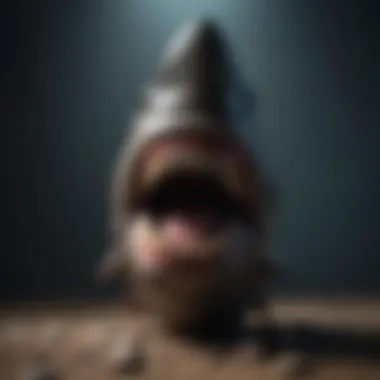
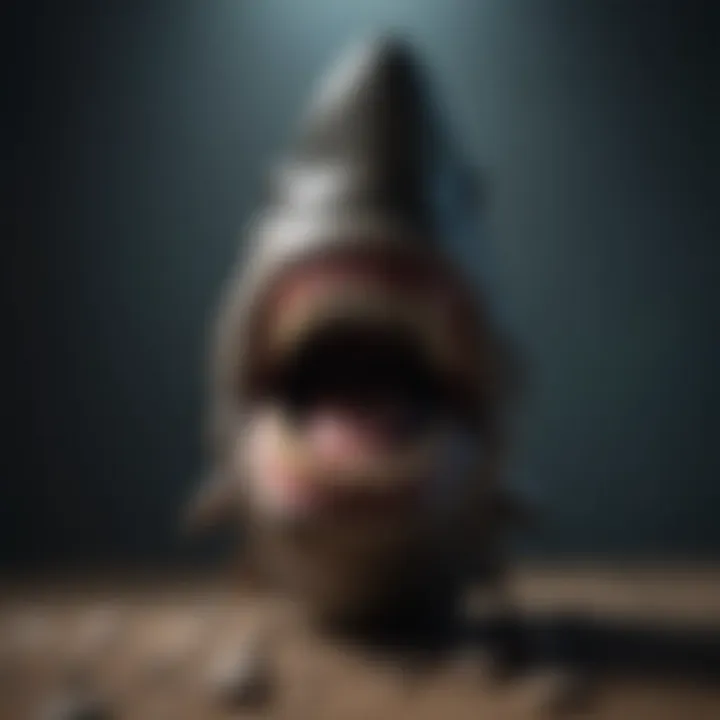
Authenticity and Provenance
When diving into the world of megalodon teeth, one aspect often surfaces as both significant and complex: authenticity and provenance. These elements play a pivotal role in shaping the value, appeal, and trustworthiness of these ancient relics.
Authenticity, simply put, refers to whether a megalodon tooth is genuine or not. Unfortunately, the market is rife with fakes, crafted to deceive unsuspecting collectors. Buyers need to step cautiously and arm themselves with knowledge, as the implications of acquiring a counterfeit can range from financial loss to emotional disappointment.
On the other hand, provenance relates to the history of a specific tooth's ownership. Knowing where a tooth has been, its previous owners, and how it was found can drastically elevate its value. This aspect appeals particularly to collectors who seek not just a fossil but a story behind it. The fusion of authenticity and provenance allows buyers to appreciate their teeth on several levels, from scientific relevance to historical storytelling.
Identifying Fake Teeth
Common Forgery Techniques
When it comes to recognizing common forgery techniques, many methods are used by unscrupulous individuals to produce convincing replicas of megalodon teeth. One prevalent technique involves the use of synthetic materials that mimic the physical properties of real teeth. While some forgers may attempt to etch in details that mirror authentic markings, the overall structure typically lacks the complexities found in genuine specimens.
- Resin Casting: This method is favored by forgers because it allows for rapid production and can be easily painted to resemble fossilized teeth.
- Handcrafted Replicas: Some forgers painstakingly craft replicas; however, they often overlook fine details unique to genuine teeth, such as wear patterns and imperfections.
A key characteristic of these forgery techniques is that they often miss the minute details that real collectors recognize. As buyers become more aware, these techniques can lose their effectiveness, making it crucial for collectors to stay informed about the latest methods in use.
Indicators of Authenticity
The indicators of authenticity give you a roadmap to navigate the often murky waters of the megalodon tooth market. Authentic teeth exhibit certain distinctive features that are challenging to imitate. For instance, real megalodon teeth often show natural wear and discoloration that speaks to their age.
- Matrix Attachment: Teeth found in a geological matrix provide a layer of authenticity that simply cannot be faked.
- Unique Surface Patterns: Authentic teeth display natural patterns or striations that reveal their unique formation process.
Understanding these indicators is beneficial for collectors who want to ensure their purchases are genuine. However, newcomers may not easily spot these details, so reaching out to experts for guidance or investing in educational resources is always a good move.
Importance of Provenance
Tracking Ownership History
The importance of tracking ownership history cannot be overstated for those who wish to invest in megalodon teeth. Knowing previous owners can not only elevate the monetary value of a tooth but may also reveal fascinating historical context. For instance, if a tooth was once part of an esteemed collection or displayed in a reputable museum, its worth may skyrocket.
- Historical Insight: A well-documented ownership history enriches the narrative surrounding a specimen.
- Market Trust: Provenance often reassures potential buyers of a tooth's authenticity, leading to smoother sales transactions.
Despite its advantages, maintaining a complete ownership history can become challenging, especially with older specimens or those passed down through generations.
Verification Processes
Verification processes entail a series of measures aimed at confirming a megalodon tooth's authenticity and provenance. These processes might include scientific testing, such as radiocarbon dating or DNA analysis, which bolster claims about the tooth's age and origin.
- Documentation: Acquiring certificates from recognized organizations can substantiate authenticity, providing buyers with peace of mind.
- Expert Appraisal: Consulting professionals in paleontology or certified appraisers is often a crucial step in confirming both authenticity and provenance.
However, the verification process can sometimes be cumbersome and may incur additional costs. It’s essential for collectors to weigh the potential benefits against the financial outlay to make informed decisions.
The Role of Megalodon Teeth in Paleontology
The role of megalodon teeth in paleontology extends beyond mere fascination; they serve as key artifacts that unlock a deeper understanding of prehistoric life, evolutionary biology, and environmental change. These ancient relics are more than just collector's items; they represent a window into the world millions of years ago when the oceans teemed with formidable creatures. Their study contributes significantly to various scientific domains, offering invaluable insights into the megalodon's life cycle, its predation patterns, and the ecological implications of its existence.
Educational Significance
Megalodon teeth stand as remarkable educational tools in various settings, from classrooms to museums. They capture attention and inspire curiosity among students and enthusiasts alike.
- Hands-On Learning: Having an authentic piece of history, like megalodon teeth, facilitates tactile learning. Students can study their structure, size, and characteristics firsthand, reinforcing concepts discussed in textbooks.
- Interdisciplinary Studies: These fossils offer an opportunity to bridge multiple fields. They serve as a foundation for discussions in biology, paleontology, geology, and environmental science, providing a multi-faceted learning experience.
- Promoting Conservation Awareness: Education around megalodon teeth often segues into broader conversations about ocean conservation and the importance of protecting modern marine ecosystems. By understanding these ancient giants, learners can appreciate and advocate for current species at risk.
Research Contributions
Megalodon teeth make significant contributions to ongoing research in paleontology, offering clues that reveal details about the megalodon's life.
- Evolutionary Insights: Researchers study teeth to understand the evolutionary lineage of sharks and their adaptations over time. The structure and morphology of megalodon teeth illustrate how these adaptations played a role in their predatory efficiency.
- Ecological Indicators: Analyzing the wear and tear on teeth can inform scientists about the megalodon's diet and hunting strategies. This information reflects the ecological dynamics of the period when megalodon thrived, shedding light on marine ecosystems' complexity.
"Megalodon teeth serve as critical indicators for scientists, mapping the ecological landscape of ancient oceans - a glimpse into a world long gone."
- Paleoenvironment Reconstruction: Findings related to megalodon teeth assist in reconstructing past environments. They help specialists understand climate changes, oceanic conditions, and the evolutionary pressures that shaped marine life during the Cenozoic era.
Museum Displays
Megalodon teeth have earned their place in museum exhibits, attracting both the casual visitor and the dedicated researcher.
- Captivating Exhibits: The sheer size of some megalodon teeth leaves an indelible impression. Their display not only draws visitors but also encourages exploration into the history of life on Earth.
- Interactivity and Engagement: Many museums incorporate interactive elements related to megalodon teeth, allowing visitors to touch replicas or engage in augmented reality experiences. This approach not only enhances visitor experience but also deepens understanding of paleontological research.
- Public Outreach: Exhibits featuring megalodon teeth often act as a conduit for public engagement with science. They can inspire future generations of paleontologists and marine biologists, fostering a culture of curiosity and inquiry.
Collecting Megalodon Teeth
Collecting megalodon teeth is not just a hobby; it’s an adventure that connects enthusiasts with an ancient past. The size, beauty, and unique nature of these fossils make them a fascinating pursuit for both casual collectors and serious paleontologists. Beyond their physical attributes, these teeth tell a story about a time long gone, drawing people in with their historical relevance and distinct allure.
Starting Your Collection
Where to Find Samples
Finding samples of megalodon teeth is akin to a treasure hunt. Many collectors suggest coastal areas where sedimentary rock is more common. Places like South Carolina, Florida, and even some beaches in North Carolina are hotspots for fossil hunters. The characteristic dark colors of megalodon teeth, often contrasted against the sandy beach, make them not just a find but a spectacular sight. The allure of these regions is their rich geological history, where water once roamed and hosted these magnificent creatures.
The benefit of these locations is twofold: not only is the possibility of finding an authentic megalodon tooth high, but it also provides a beautiful backdrop for the hunt. However, it's worth mentioning that some beaches may have regulations limiting fossil collection. Thus, knowing local laws is key.
Etiquette of Collecting
Engaging in the etiquette of collecting megalodon teeth can make you a respected member of the community. A key characteristic of this etiquette is practicing respect for nature and other collectors. This means leaving no trace, advocating for conservation, and sharing discovery stories thoughtfully. Being considerate can enhance one’s experience, making it not only fruitful but also enjoyable.
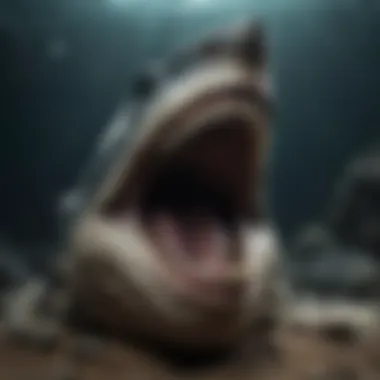
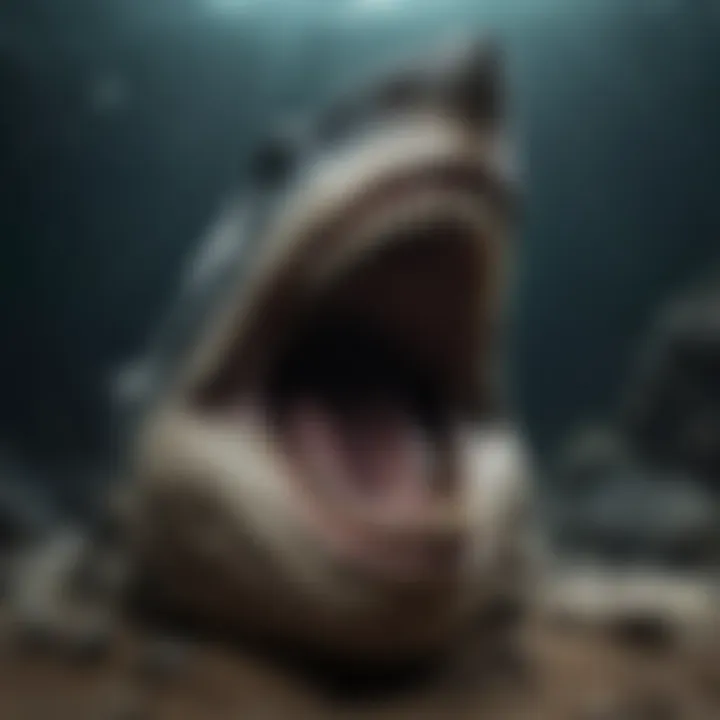
Additionally, it helps build a good reputation among fellow fossil collectors. Establishing relationships in this community can lead to valuable insights, shared locations, or even trades. However, one downside might arise from overly competitive collectors. Maintaining a sense of camaraderie, rather than rivalry, ensures that the joy of collecting isn’t overshadowed by tension.
Care and Preservation
Taking care of your megalodon teeth is just as crucial as finding them. Proper preservation can maintain their integrity over time, allowing future generations to appreciate these ancient treasures.
Cleaning Techniques
Cleaning megalodon teeth should be done with utmost care. Many collectors recommend using a soft brush and water to remove dirt without damaging the tooth's surface. Avoiding harsh chemicals is important because they can cause discoloration or deterioration. Ensuring that the tooth is clean will highlight its features, making it more visually appealing.
One unique aspect of cleaning techniques is the method of using simple sandblasting. It's efficient but requires practice. This method can bring out details but might harm a tooth's surface if you're not careful. The trade-off between risk and reward makes choosing the right cleaning method essential.
Storage Recommendations
Storing your collection is equally as critical. For megalodon teeth, using display cases with UV protection can prevent fading over time. It's best to keep them in a climate-controlled environment away from direct sunlight or moisture. The benefit of using a display case is clear; it showcases your collection while preventing damage. However, some collectors prefer loose storage, which may expose the teeth to potential scratches.
Ultimately, the unique feature of good storage reflects your commitment to preserving history. As for downsides, displaying teeth in high-traffic areas can increase the risk of accidental damage.
The Economics of Megalodon Teeth
The realm of megalodon teeth is not merely a fascinating journey into prehistoric life; it also presents an entire ecosystem of economic dynamics. Understanding the economics surrounding these ancient teeth gives collectors vital insights into not just price tags but also market behaviors, investment considerations, and the cultural significance of these relics. Whether you’re a hobbyist or a seasoned collector, grasping these intricate financial threads enhances appreciation and offers strategic advantages in this niche marketplace.
Price Ranges
Typical Pricing
When looking at megalodon teeth, the typical pricing serves as a foundational understanding of what collectors might expect to pay. Generally, you’re looking at a range that varies greatly, from modest finds priced around $20 to larger specimens reaching upwards of several hundred dollars. The key characteristic here is variability; factors like size, condition, and color can shift prices dramatically. For newcomers to collecting, this pricing structure is beneficial as it allows for entry-level pieces that won't break the bank, helping buyers build their confidence gradually in the market.
Moreover, typical pricing helps establish a fair baseline for what constitutes a reasonable deal. It’s always advantageous to be informed—for instance, knowing that a shark tooth around three inches can fetch around $50 helps in negotiations when you decide to expand your collection.
High-End Collectible Ranges
On the other end of the spectrum are the high-end collectible ranges, where pricing can soar, often exceeding thousands of dollars. What elevates these teeth to such prices? Factors include exceptional size, pristine condition, and unique features like fossilization patterns or locality significance. Collectors gravitate towards these pieces due to their rarity and the prestige they associate with ownership.
A unique feature of high-end collectibles is the allure of potential future value; collectors often see these as not only purchase decisions but also investment opportunities. However, one must be cautious—while high-end pieces can offer returns, they also carry higher risks associated with fakes or poorly documented provenance, which can severely impact their value.
Investment Potential
Long-Term Value Trends
The long-term value trends of megalodon teeth offer a snapshot into the investment landscape. Unlike many collectibles that fluctuate daily, megalodon teeth have demonstrated a remarkable resilience in value over time. Thanks to their intrinsic rarity and continuous fascination from the public, these teeth have often appreciated steadily. Collectors looking at megalodon teeth as investments usually keep an eye on auction results and sales data to gauge future price shifts.
In this space, the unique feature is the combination of emotional appeal and economic worth. Many buyers are not just in it for the investment; the passion for paleontology adds depth to their holdings. However, would-be investors must consider that the market can at times be cyclical, influenced by broader economic factors and trends in fossil collecting.
Resale Market Insights
When it comes to resale market insights, understanding the ebb and flow of demand can greatly inform selling strategies. As collectors move on or decide to upgrade their collections, the resale market becomes a vital area to assess pricing and potential profit margins. The key characteristic of this market is its fluidity; once a price point is set, it can change rapidly based on current trends, interests, and the discovery of new pieces.
Unique to the resale market is its dual nature: while it can be profitable, it also requires a network of knowledgeable buyers and sellers. Those entering this market should be mindful that while selling can yield significant returns, it also demands a certain level of expertise in identifying the right time to sell, understanding buyer motivations, and ensuring the authenticity of what is being sold.
"Investing in megalodon teeth is as much about passion as it is about profit; knowing the market goes hand-in-hand with love for the ancient past."
The economics of megalodon teeth reveals a rich landscape that extends beyond simple acquisition—it's about investments, trends, and the sheer appreciation of history encapsulated in a single tooth.
Cultural Impact of Megalodon Teeth
The cultural significance of megalodon teeth goes beyond mere collectibles; they are intertwined with the human experience. From ancient traditions to modern-day art, these fossilized relics have become powerful symbols that reflect various societal beliefs and narratives. Their allure captivates not just earnest collectors but also those with an appreciation for history and nature's wonders.
Exploring the cultural impact of megalodon teeth unveils a rich tapestry of interpretations, representing power, danger, and the passage of time, making them valuable artifacts in multiple civilizations.
Symbolism in Various Cultures
Megalodon teeth often serve as harbingers of strength and ferocity in many cultures. In some maritime societies, they are held in high esteem, symbolizing not only physical power but also protection against the unpredictable forces of nature. Fishermen, for instance, tend to carry these teeth as charms, believing they might ward off ill-fated encounters at sea.
- In Polynesian mythology, the shark holds significant status. The megalodon, in particular, becomes emblematic of the ocean’s might. This sends a message: respect the water, for it harbors massive creatures and unpredictable tides.
- African tribal rituals sometimes incorporate megalodon teeth as symbols of fearlessness and bravery. Warriors would adorn themselves with these pivotal pieces, intended to instill fear in their enemies.
Megalodon teeth, sometimes referred to as "mermaid's teeth," also show up in local legends. In coastal communities, tales weave thick personalities around these ancient relics. These tales often tell of sailors who wore them as amulets, believing they held the essence of the megalodon itself.
Megalodon Teeth in Art and Lore
In the realm of art and popular culture, megalodon teeth frequently find themselves front and center. Artists draw inspiration from their striking appearance and robust history. They become metaphors for extinction, reminding us of beings that once dominated our oceans but now reside in the annals of history.
In literature, they often pop up in stories about ocean adventures, where they evoke images of danger lurking in the deep blue, capturing the fascination of readers.
- Film and Cinema: From classic monster flicks, like "Jaws," to the more recent blockbuster hits, megalodon teeth are often used as a prop to signify terror and power. These films heighten the mythical reputation of the megalodon, emphasizing its role as one of the fiercest predators.
- Craftsmanship: Jewelry artisans often use megalodon teeth to create unique adornments. Wearing such jewelry goes beyond aesthetics; it connects the wearer to Earth’s ancient past, evoking a sense of nostalgia for a world long gone.
These cultural references do more than define mere objects. They enhance our understanding of human connection to nature, our fears, and the legacies left by creatures that roamed the Earth millions of years ago. Ultimately, megalodon teeth are not just ancient artifacts; they're gateways into our shared human history, laden with stories and meanings waiting to be uncovered.
Finale
The closing chapter regarding megalodon teeth is quite significant, as it emphasizes several key considerations that shed light on their value. Understanding the multifaceted nature of these fossils is not only about recognizing their monetary worth, but also involves appreciating their historical, cultural, and educational importance. In the realm of rock and fossil collectors, megalodon teeth represent an intersection of science and fascination.
The Legacy of Megalodon Teeth
Megalodon teeth have a legacy steeped in both myth and reality. For many collectors, these fossils are not mere objects to be hoarded; they embody a connection to Earth's ancient past, a tangible link to a time when creatures as large as a bus roamed the seas. The allure lies in their sheer size, the craftsmanship of their natural formation, and the stories they tell.
- Cultural Symbolism
They often find their way into various cultural narratives, representing strength or ferocity in many societies. Just as a lion’s tooth can symbolize courage, a megalodon’s tooth evokes images of fearsome power, contributing to its place in art and literature. - Educational Value
These teeth serve as potent educational tools, not just for paleontology enthusiasts who wish to deepen their knowledge. They help bring to life the science of evolution and the history of marine ecosystems. Schools and museums leverage their presence to inspire curiosity among students, leaving a lasting impression about Earth's timeline. - Collector's Pride
Within the collector community, owning a piece of this legacy garners respect. Whether displayed on a mantel or used to spark conversation, megalodon teeth radiate an air of historical significance. The presence of an expertly preserved tooth can demonstrate a collector's understanding and appreciation of paleontological history. - Market Dynamics
Additionally, the economic implications tied to megalodon teeth cannot be ignored. The demand continually fluctuates due to trends in collecting, and every sale contributes to an ongoing conversation about the valuation of these prehistoric remnants. This engagement keeps the community connected, and the excitement surrounding auction events or exhibit openings draws enthusiasts together, solidifying the place of megalodon teeth in modern culture.
The legacy of megalodon teeth transcends mere fossil collection; it is a celebration of our planet’s history and the intersection of culture, science, and art.
Ultimately, the legacy of megalodon teeth is not limited to what they represent in the marketplace. It is about understanding their significance on a broader scale, as we reflect on our world and the ancient beings that once graced it. For rock and fossil collectors, this perspective enriches the experience of collecting, turning each acquisition into a meaningful chapter in the narrative of our shared natural heritage.



